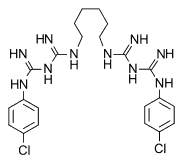Millions of peripheral and central intravascular catheters are used in the United States each year. Introduction of an intravascular catheter can lead to bloodstream infections, and mortality rates from these catheter-related infections have been estimated at 10 to 20 percent, increasing medical costs up to $15,000. Povidone-iodine is the most common catheter-site disinfectant, but accumulating evidence has indicated that chlorhexidine gluconate may be a more effective agent. Chaiyakunapruk and colleagues reviewed pooled data from a number of recent randomized controlled trials to compare the clinical effectiveness and cost-effectiveness of substituting chlorhexidine for povidone-iodine when disinfecting catheter insertion sites.
The decision analysis model adopted by the authors presumed that disinfectant agents were used at the time of catheter placement and reapplied every 48 to 72 hours to cleanse the insertion site. Short-term catheter use (fewer than 10 days) was examined because this is the most common clinical scenario encountered in hospitals.
The authors estimated rates of catheter colonization, bloodstream infection, and mortality risk by pooling data from randomized controlled trials comparing the two disinfectants.
The associated costs of catheter-related infection were based on the presumption that each central catheter infection would result in five extra days in intensive care, blood and catheter tip cultures, antibiotic susceptibility testing, and one week of intravenous vancomycin therapy, for a cost of about $7,113. Peripheral catheter infections were estimated to incur added costs of approximately $1,534. For seven days of care, chlorhexidine had an additional cost of $1.53 for central catheter care and $0.12 for peripheral catheters.
The pooled data indicated that using chlorhexidine instead of povidone-iodine for central catheter care reduced the rates of bloodstream infection (from 31 to 15 cases per 1,000 catheters) and mortality risk (from four to two cases per 1,000 catheters) by approximately one half. A similar reduction was noted for peripheral catheters, though the base rates of infection and death were lower. Total cost savings because of decreased morbidity were estimated at $113 for each central catheter and $8 for each peripheral catheter.
The authors conclude that use of chlorhexidine gluconate instead of povidone-iodine for disinfection of intravascular catheter sites is clinically effective and cost-effective.
Chaiyakunapruk N, et al. Vascular catheter site care: the clinical and economic benefits of chlorhexidine gluconate compared with povidone iodine. Clin Infect Dis September 15, 2003;37:764-71.
EDITOR'S NOTE: A savings of $8 per peripheral catheter is never going to make headlines, but when this savings is multiplied by the millions of catheters used each year and enhanced by decreased morbidity and mortality, it is perhaps a more compelling reason to dispense with the traditional iodine preparation and move on to a more effective agent.--B.Z.
COPYRIGHT 2004 American Academy of Family Physicians
COPYRIGHT 2004 Gale Group



